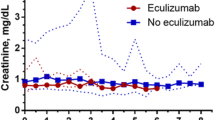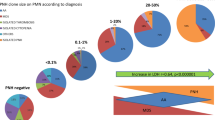Abstract
We retrospectively assessed the clinical characteristics of patients with paroxysmal nocturnal hemoglobinuria (PNH) according to severity of cytopenia. A total of 282 patients with hematological parameters assessed at the time of diagnosis of PNH were included. There were 24 patients with PNH/severe aplastic anemia (SAA) (at least two of the three criteria; hemoglobin ≤8 g/dL; absolute neutrophil count (ANC) <0.5 × 109/L; platelet count <20 × 109/L), 96 patients with PNH/aplastic anemia (AA) (at least two of the three criteria; hemoglobin ≤10 g/dL; ANC 0.5–1.5 × 109/L; platelet count 20–100 × 109/L), and 162 classic PNH patients. Compared with the classic PNH subgroup, the PNH/SAA subgroup had a significantly lower median granulocyte PNH clone size (26.7 vs. 51.0 %, P = 0.021) and lower incidence of lactate dehydrogenase ≥1.5 times the upper limit of normal (52.9 vs. 80.0 %, P = 0.049). The incidence of thromboembolism was similar in both subgroups. Overall survival was significantly lower in the PNH/SAA subgroup than in the classic PNH subgroup (P = 0.033). Our findings suggest that identification of patients with PNH/SAA at the time of diagnosis is important because of different clinical manifestations and poorer outcome compared with patients with classic PNH (clinicaltrials.gov identifier: #NCT01224483).




Similar content being viewed by others
References
Hillmen P, Lewis SM, Bessler M, Luzzatto L, Dacie JV (1995) Natural history of paroxysmal nocturnal hemoglobinuria. N Engl J Med 333(19):1253–1258. doi:10.1056/NEJM199511093331904
Parker CJ (2012) Paroxysmal nocturnal hemoglobinuria. Curr Opin Hematol 19(3):141–148. doi:10.1097/MOH.0b013e328351c348
Socie G, Mary JY, de Gramont A, Rio B, Leporrier M, Rose C, Heudier P, Rochant H, Cahn JY, Gluckman E (1996) Paroxysmal nocturnal haemoglobinuria: long-term follow-up and prognostic factors. French Society of Haematology. Lancet 348(9027):573–577
Nishimura J, Kanakura Y, Ware RE, Shichishima T, Nakakuma H, Ninomiya H, Decastro CM, Hall S, Kanamaru A, Sullivan KM, Mizoguchi H, Omine M, Kinoshita T, Rosse WF (2004) Clinical course and flow cytometric analysis of paroxysmal nocturnal hemoglobinuria in the United States and Japan. Medicine (Baltimore) 83(3):193–207
Lee JW, Jang JH, Kim JS, Yoon SS, Lee JH, Kim YK, Jo DY, Chung J, Sohn SK (2013) Clinical signs and symptoms associated with increased risk for thrombosis in patients with paroxysmal nocturnal hemoglobinuria from a Korean Registry. Int J Hematol 97(6):749–757. doi:10.1007/s12185-013-1346-4
Brodsky RA (2008) Paroxysmal nocturnal hemoglobinuria: stem cells and clonality. Hematology Am Soc Hematol Educ Program:111–115. doi:10.1182/asheducation-2008.1.111
Pu JJ, Brodsky RA (2011) Paroxysmal nocturnal hemoglobinuria from bench to bedside. Clin Transl Sci 4(3):219–224. doi:10.1111/j.1752-8062.2011.00262.x
de Latour RP, Mary JY, Salanoubat C, Terriou L, Etienne G, Mohty M, Roth S, de Guibert S, Maury S, Cahn JY, Socie G, French Society of H, French Association of Young H (2008) Paroxysmal nocturnal hemoglobinuria: natural history of disease subcategories. Blood 112(8):3099–3106. doi:10.1182/blood-2008-01-133918
Parker C, Omine M, Richards S, Nishimura J, Bessler M, Ware R, Hillmen P, Luzzatto L, Young N, Kinoshita T, Rosse W, Socie G, International PNHIG (2005) Diagnosis and management of paroxysmal nocturnal hemoglobinuria. Blood 106(12):3699–3709. doi:10.1182/blood-2005-04-1717
Pu JJ, Mukhina G, Wang H, Savage WJ, Brodsky RA (2011) Natural history of paroxysmal nocturnal hemoglobinuria clones in patients presenting as aplastic anemia. Eur J Haematol 87(1):37–45. doi:10.1111/j.1600-0609.2011.01615.x
Raza A, Ravandi F, Rastogi A, Bubis J, Lim SH, Weitz I, Castro-Malaspina H, Galili N, Jawde RA, Illingworth A (2014) A prospective multicenter study of paroxysmal nocturnal hemoglobinuria cells in patients with bone marrow failure. Cytometry B Clin Cytom 86(3):175–182. doi:10.1002/cyto.b.21139
Schrezenmeier H, Muus P, Socie G, Szer J, Urbano-Ispizua A, Maciejewski JP, Brodsky RA, Bessler M, Kanakura Y, Rosse W, Khursigara G, Bedrosian C, Hillmen P (2014) Baseline characteristics and disease burden in patients in the International Paroxysmal Nocturnal Hemoglobinuria Registry. Haematologica 99(5):922–929. doi:10.3324/haematol.2013.093161
Hillmen P, Young NS, Schubert J, Brodsky RA, Socie G, Muus P, Roth A, Szer J, Elebute MO, Nakamura R, Browne P, Risitano AM, Hill A, Schrezenmeier H, Fu CL, Maciejewski J, Rollins SA, Mojcik CF, Rother RP, Luzzatto L (2006) The complement inhibitor eculizumab in paroxysmal nocturnal hemoglobinuria. N Engl J Med 355(12):1233–1243. doi:10.1056/NEJMoa061648
Kim JS, Lee JW, Kim BK, Lee JH, Chung J (2010) The use of the complement inhibitor eculizumab (Soliris(R)) for treating Korean patients with paroxysmal nocturnal hemoglobinuria. Korean J Hematol 45(4):269–274. doi:10.5045/kjh.2010.45.4.269
Peffault de Latour R, Schrezenmeier H, Bacigalupo A, Blaise D, de Souza CA, Vigouroux S, Willemze R, Terriou L, Tichelli A, Mohty M, de Guibert S, Marsh JC, Passweg J, Yves Mary J, Socie G (2012) Allogeneic stem cell transplantation in paroxysmal nocturnal hemoglobinuria. Haematologica 97(11):1666–1673. doi:10.3324/haematol.2012.062828
Pantin J, Tian X, Geller N, Ramos C, Cook L, Cho E, Scheinberg P, Vasu S, Khuu H, Stroncek D, Barrett J, Young NS, Donohue T, Childs RW (2014) Long-term outcome of fludarabine-based reduced-intensity allogeneic hematopoietic cell transplantation for debilitating paroxysmal nocturnal hemoglobinuria. Biol Blood Marrow Transplant 20(9):1435–1439. doi:10.1016/j.bbmt.2014.05.012
Brodsky RA, Young NS, Antonioli E, Risitano AM, Schrezenmeier H, Schubert J, Gaya A, Coyle L, de Castro C, Fu CL, Maciejewski JP, Bessler M, Kroon HA, Rother RP, Hillmen P (2008) Multicenter phase 3 study of the complement inhibitor eculizumab for the treatment of patients with paroxysmal nocturnal hemoglobinuria. Blood 111(4):1840–1847. doi:10.1182/blood-2007-06-094136
Marsh JC, Ball SE, Cavenagh J, Darbyshire P, Dokal I, Gordon-Smith EC, Keidan J, Laurie A, Martin A, Mercieca J, Killick SB, Stewart R, Yin JA, British Committee for Standards in H (2009) Guidelines for the diagnosis and management of aplastic anaemia. Br J Haematol 147(1):43–70. doi:10.1111/j.1365-2141.2009.07842.x
Brodsky RA (2009) How I treat paroxysmal nocturnal hemoglobinuria. Blood 113(26):6522–6527. doi:10.1182/blood-2009-03-195966
Brodsky RA (2010) Stem cell transplantation for paroxysmal nocturnal hemoglobinuria. Haematologica 95(6):855–856. doi:10.3324/haematol.2010.023176
Kelly RJ, Hill A, Arnold LM, Brooksbank GL, Richards SJ, Cullen M, Mitchell LD, Cohen DR, Gregory WM, Hillmen P (2011) Long-term treatment with eculizumab in paroxysmal nocturnal hemoglobinuria: sustained efficacy and improved survival. Blood 117(25):6786–6792. doi:10.1182/blood-2011-02-333997
Lee JL, Lee JH, Lee JH, Choi SJ, Kim S, Seol M, Lee YS, Chi HS, Park CJ, Kim WK, Lee JS, Lee KH (2003) Allogeneic hematopoietic cell transplantation for paroxysmal nocturnal hemoglobinuria. Eur J Haematol 71(2):114–118
Scheinberg P, Young NS (2012) How I treat acquired aplastic anemia. Blood 120(6):1185–1196. doi:10.1182/blood-2011-12-274019
Kulagin A, Lisukov I, Ivanova M, Golubovskaya I, Kruchkova I, Bondarenko S, Vavilov V, Stancheva N, Babenko E, Sipol A, Pronkina N, Kozlov V, Afanasyev B (2014) Prognostic value of paroxysmal nocturnal haemoglobinuria clone presence in aplastic anaemia patients treated with combined immunosuppression: results of two-centre prospective study. Br J Haematol 164(4):546–554. doi:10.1111/bjh.12661
Sugimori C, Chuhjo T, Feng X, Yamazaki H, Takami A, Teramura M, Mizoguchi H, Omine M, Nakao S (2006) Minor population of CD55-CD59- blood cells predicts response to immunosuppressive therapy and prognosis in patients with aplastic anemia. Blood 107(4):1308–1314. doi:10.1182/blood-2005-06-2485
Hall C, Richards S, Hillmen P (2003) Primary prophylaxis with warfarin prevents thrombosis in paroxysmal nocturnal hemoglobinuria (PNH). Blood 102(10):3587–3591. doi:10.1182/blood-2003-01-0009
Moyo VM, Mukhina GL, Garrett ES, Brodsky RA (2004) Natural history of paroxysmal nocturnal haemoglobinuria using modern diagnostic assays. Br J Haematol 126(1):133–138. doi:10.1111/j.1365-2141.2004.04992.x
Hill A, Kelly RJ, Hillmen P (2013) Thrombosis in paroxysmal nocturnal hemoglobinuria. Blood 121(25):4985–4996. doi:10.1182/blood-2012-09-311381, quiz 5105
Acknowledgments
This study was presented in the form of a poster presentation at the 52nd annual meeting of the American Society of Hematology, Orlando, FL, December 4–7, 2010. This work was supported by the Korean Society of Hematology.
Conflict of interest
All authors declare that they have no conflicts of interest.
Author information
Authors and Affiliations
Corresponding author
Additional information
Jin Seok Kim and Jun Ho Jang contributed equally to this work.
Rights and permissions
About this article
Cite this article
Kim, J.S., Jang, J.H., Yoon, SS. et al. Distinct subgroups of paroxysmal nocturnal hemoglobinuria (PNH) with cytopenia: results from South Korean National PNH Registry. Ann Hematol 95, 125–133 (2016). https://doi.org/10.1007/s00277-015-2511-z
Received:
Accepted:
Published:
Issue Date:
DOI: https://doi.org/10.1007/s00277-015-2511-z




